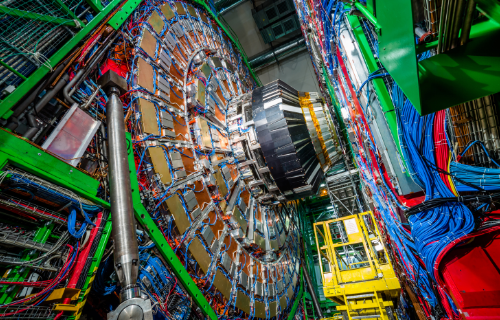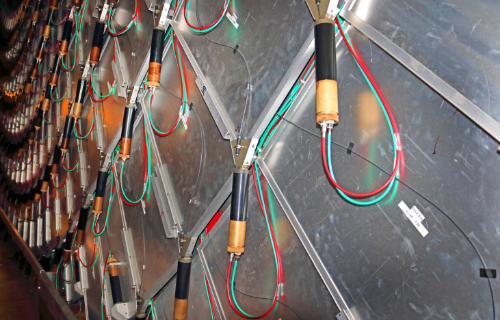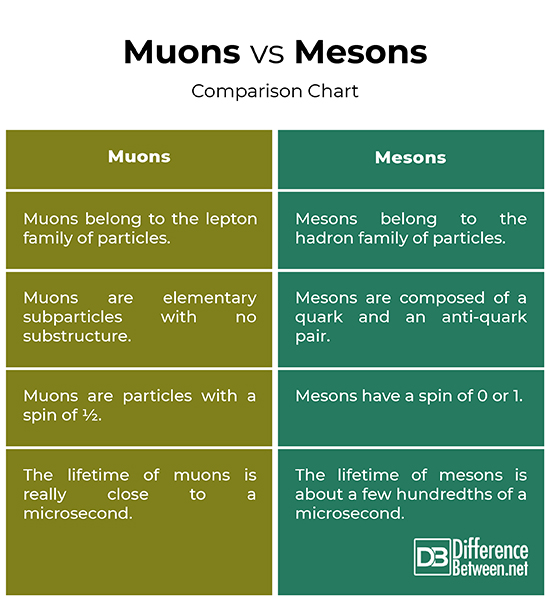Difference Between Muons and Mesons
All the particles in the matter can be classified in terms of their masses and interactions into hadrons and leptons. Hadrons are the heaviest of all particles and are made of quarks, anti-quarks, and gluons. Hadrons are basically a catch-all term for materials that are made from quarks. They are further classified into two distinct groups: baryons and mesons. Leptons, on the other hand, are an elementary particle not affected by the strong nuclear forces. They are further divided into three main groups: electrons, muons, and tau. In this article, we’ll be talking about mesons and muons, while figuring out the key differences between the two.

What are Mesons?
Mesons are unstable subatomic particles of the hadron family composed of a quark and an anti-quark pair. These pairs are held inside the particle by strong interactions. The quark and the anti-quark do not have to be of the same flavor. Any combination is possible, although some can be less stable than the others. Another way to define mesons is as hadrons that will never decay into protons, or into any particles that could subsequently decay into a proton. Mesons are more massive than electrons but less massive than protons or neutrons.
This means the mass of a meson is always less than the mass of a proton because if meson is greater than the mass of a proton, it would start to decay to become the more stable particle. In fact, a meson is intermediate in mass between an electron and a proton. There are primarily two types of mesons which are common in interactions – the pion and the kaon.

What are Muons?
Muons are also unstable subatomic particles but belong to the lepton family of particles. They are basically elementary particles with no substructure. Muons are fermions which are categorized as leptons. They have the negative charge as electrons but with a much greater mass, about 200 times heavier. Muons are made when cosmic rays strike every square meter of the Earth’s upper atmosphere, creating a shower of fundamental particles, including muons. Unlike mesons, they spontaneously decay into electrons or positrons and some neutrinos. The lifetime of muons is really close to a microsecond, so it’s kind of beautifully appropriate.
Difference between Muons and Mesons
Property
– Mesons are unstable subatomic particles of the hadron family composed of a quark and an anti-quark pair which are held inside the particle by strong interactions. The name meson comes from the Greek word “mesos” which means intermediate. Mesons are sensitive to strong forces. Muons, on the other hand, are elementary subatomic particles of the lepton family that has no substructure. Mesons are bosons whereas muons are fermions.
Size/Spin
– Muons are one of the fundamental subatomic particles that are very small, similar to electrons but weigh more than 200 times as much. Mesons, on the other hand, are composed of quark subparticles, so they have a meaningful physical size, roughly 1.2 times the size of a proton. Muons are particles with a spin of ½ whereas mesons have a spin of 0 or 1.
Lifetime
– A meson is intermediate in mass between an electron and a proton. Mesons are hadrons that will never decay into protons, or into any particles that could subsequently decay into a proton. Unlike mesons, muons spontaneously decay into electrons or positrons and some neutrinos. The lifetime of muons is really close to a microsecond whereas the lifetime of mesons is about a few hundredths of a microsecond.
Muons vs. Mesons: Comparison Chart

Summary
All particles either belong to the hadron family or lepton family. Muons are leptons with no substructure whereas mesons are hadron subatomic particles composed of one quark and one anti-quark. Unlike mesons, muons spontaneously decay into electrons or positrons and some neutrinos. The lifetime of muons is really close to a microsecond, while the lifetime of mesons is nearly a few hundredths of a microsecond. Muons are particles with a spin of ½ whereas mesons have a spin of 0 or 1.
Is the muon a meson?
Muons were formerly called “Mu Mesons”, but cannot be classified as mesons according to the modern particle physicists.
What is the difference between meson and baryon?
Mesons composed of a quark and an anti-quark pair whereas baryons are a type of hadron with three quark particles. Mesons are bosons whereas baryons are fermions.
Is muon a lepton or meson?
Muon is a lepton which was found to be unstable and decay into an electron and neutrinos with a lifetime of 3.2 microseconds.
What’s the difference between mesons and gluons?
Gluons are massless elementary particles that bind together quarks to form hadrons whereas mesons are a combination of a quark and an anti-quark particle.
What is meson particle?
A meson is a hadronic subatomic particle composed of equal number of quark and anti-quark particles.
What type of particle is a muon?
A muon is an elementary particle of the lepton group that has the same negative charge as electrons but weigh 200 times as much.
Is muon a fermion or boson?
Muons are fermions and not bosons.
What is the difference between lepton and baryon?
Baryons are a group of subatomic particles that are composed of three quarks and they participate in strong interactions. Lepton is an elementary particle of half-integer spin that responds to weak forces.
What are examples of mesons?
Examples of mesons are pions (pi meson), kaons (K meson), and pseudoscalar mesons.
Is a proton a baryon or meson?
Protons are baryons – the only baryon stable in isolation, but with two up quarks and one down quark.
- Difference Between Caucus and Primary - June 18, 2024
- Difference Between PPO and POS - May 30, 2024
- Difference Between RFID and NFC - May 28, 2024
Search DifferenceBetween.net :
Leave a Response
References :
[0]Dosch, H.G. Beyond the Nanoworld: Quarks, Leptons, and Gauge Bosons. Florida, United States: CRC Press, 2008. Print
[1]Allday, Jonathan. Quarks, Leptons and The Big Bang: Second Edition. Florida, United States: CRC Press, 2018. Print
[2]Martin, Brian R. and Graham Shaw. Particle Physics. New Jersey, United States: John Wiley & Sons, 2013. Print
[3]Dunlap, Richard A. Particle Physics. California, United States: Morgan & Claypool Publishers, 2018. Print
[4]Anisovich, A.V., et al. Mesons and Baryons: Systematization and Methods of Analysis. Singapore: World Scientific, 2008. Print
